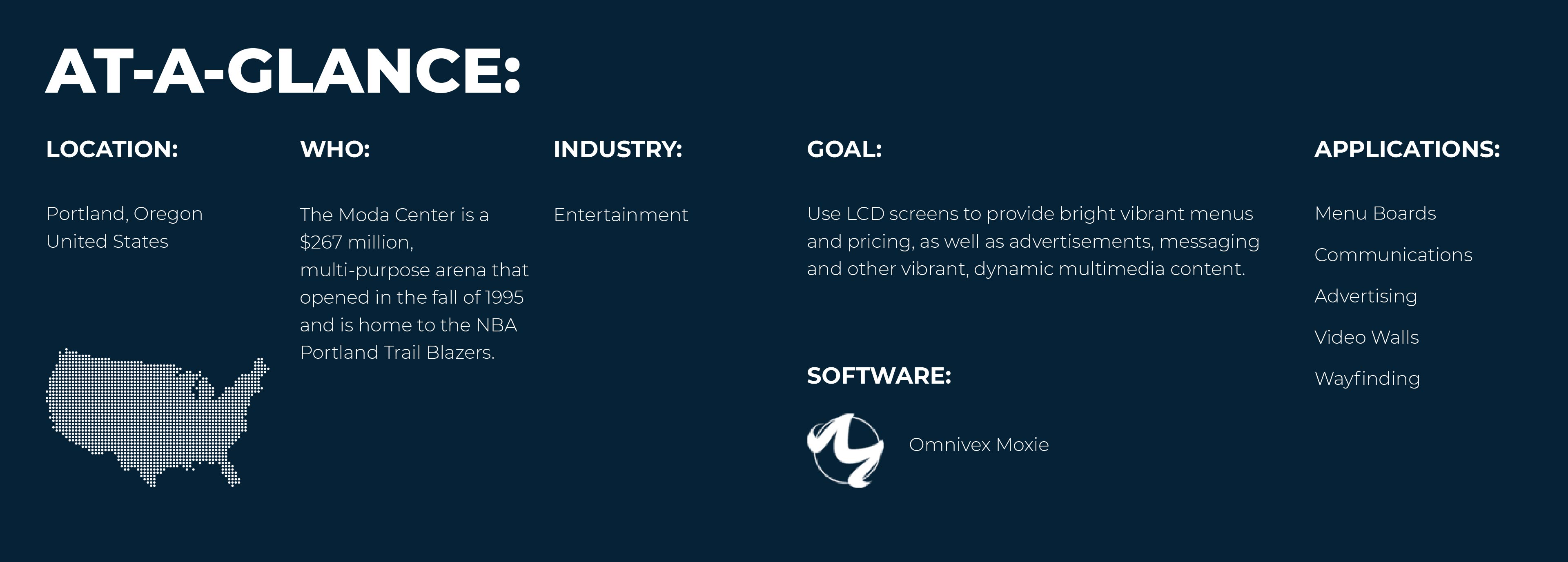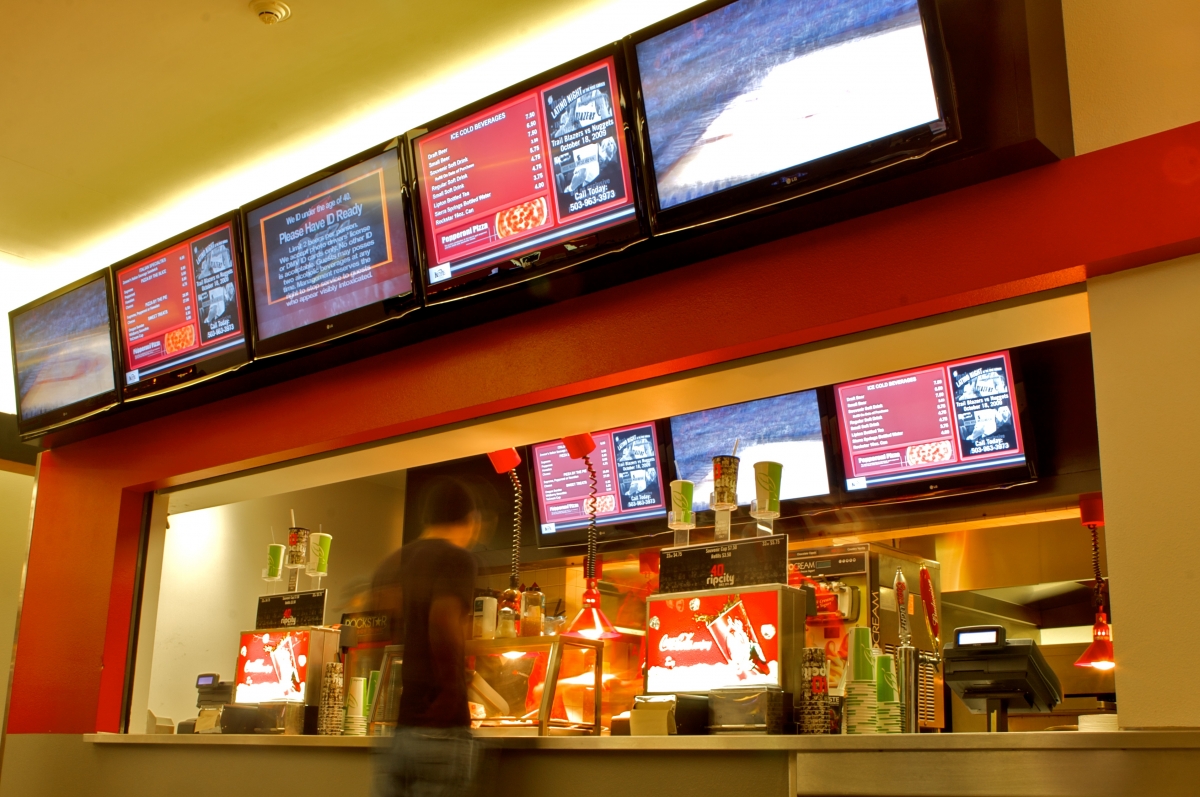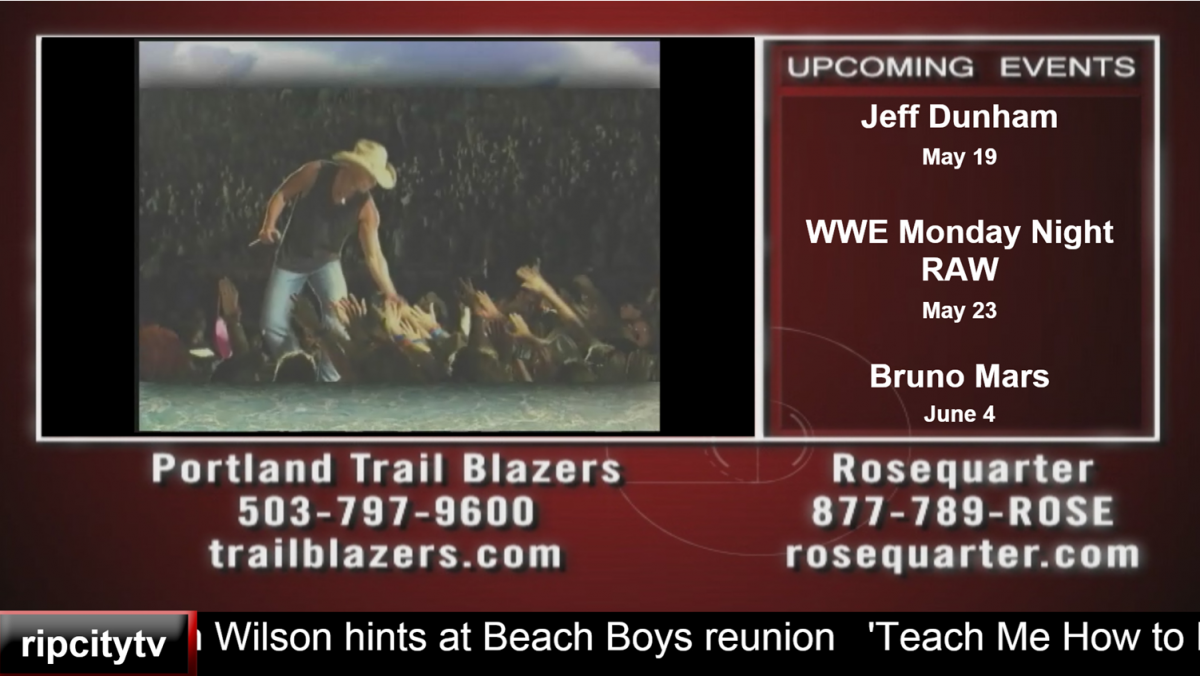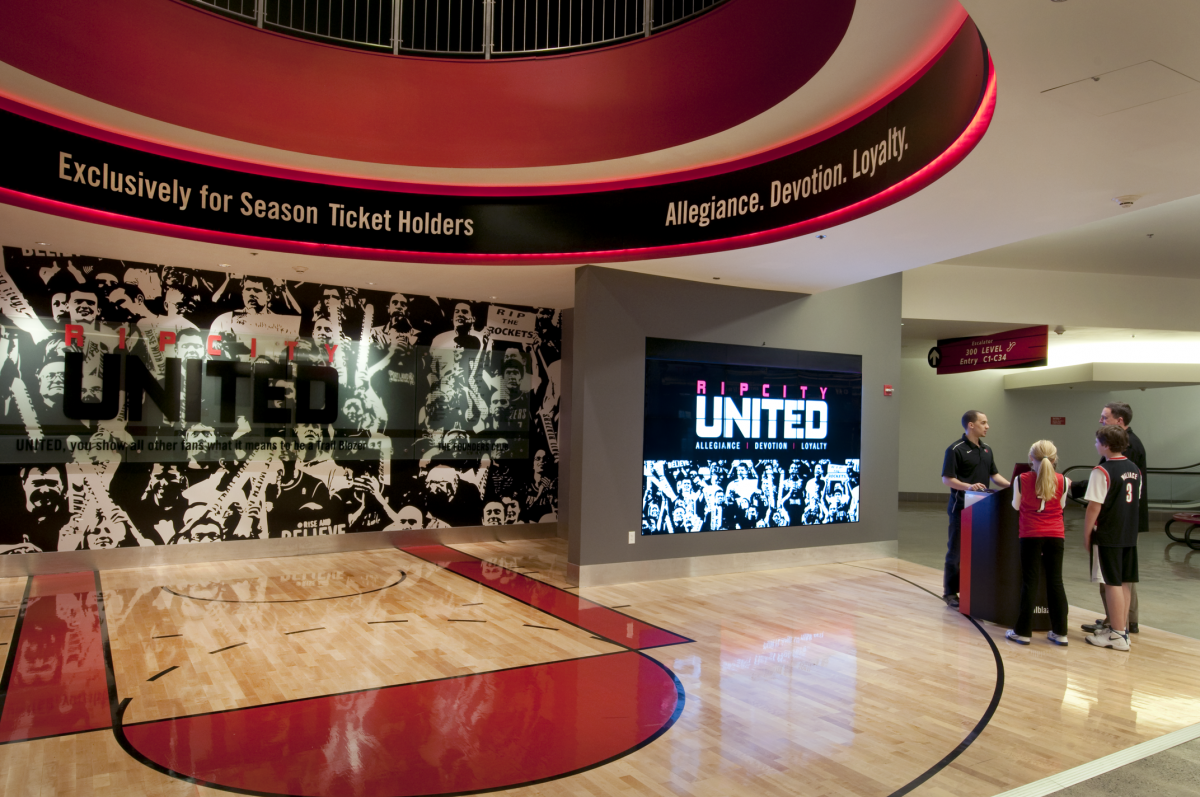
About Portland Trail Blazers
The Moda Center is a $267 million, multi-purpose arena that opened in the fall of 1995 and is home to the NBA Portland Trail Blazers. The arena is part of The Rose Quarter in Portland, Oregon and home to Portland Trail Blazers NBA franchise. The Rose Quarter includes the 20,000-seat Moda Center, 12,000-seat Veterans Memorial Coliseum, 6,500-seat Theater of the Clouds, 40,000-square foot Exhibit Hall and the Rose Quarter Commons.
The Scope
The initial phase of the digital signage implementation was concentrated within Portland's Moda Center. The first step was to replace all of the facility's concession stand cathode ray tube (CRT) screens, which were displaying a loop of menu content played on DVD players. The screens had become very outdated over time with limited functionality to do dynamic menus, so the menus were not being used to their fullest potential. In the summer of 2009, all of the Moda Center's concession CRT screens were removed and a new digital signage network consisting of over 250 LCDs was installed. "As buildings get older you start to reinvent them -- re-architect, change concourse elements and other enhancements," explained Chris Dill, VP, CIO of the Portland Trail Blazers. "In the NBA, it is about continually updating your building, adding bars, reinventing spaces, updating technology and continually improving the fan experience which can help support prices increases as needed. You need to continually improve the experience, that is why people come to events and you want to do all you can to make sure it was a good experience and that they want to return," said Dill.
The Moda Center's management team wanted the system to be much more than just a loop of content. Screens are located in each of the facility's many concession stands, within concourses, and at entrances to the facility. The goals of the project was to use current LCD screens to provide bright vibrant menus and pricing, as well as advertisements, messaging and other vibrant, dynamic multimedia content. After defining what the objectives were for the digital signage system and what the management team wanted to display on the screens, a group of technical experts was put together to evaluate software products. "There were over 300 original software products identified, of which, 8 underwent an extensive evaluation and testing process," said Dill. The main purpose of the network would be to improve the visitor experience by providing guests with clear access to information such as menu items, pricing, event information, and real-time messages.
To help reduce capital expenditures, the entire system needed to be run over the facility's existing coax cable, and it needed to be easy to use so that no additional staff had to be hired to manage it. Many different departments would be involved with the system, so there was a need for the software to allow all of the different parties to contribute to the functions that pertained to them. They had a short timeframe, as there was a hard deadline since the system needed to be up and running for the pre-season opening game.
The Solution
 Moxie software was ultimately selected to manage the Moda Center's system following extensive competitive analysis and testing. Moxie software has superior graphical capabilities, the ability to manage complex playlists and define rules related to how and when to display content. In phase one of the deployment, Moxie software was used to create content and manage the 250 screen digital signage network, which they have branded as Digital Impact.
Moxie software was ultimately selected to manage the Moda Center's system following extensive competitive analysis and testing. Moxie software has superior graphical capabilities, the ability to manage complex playlists and define rules related to how and when to display content. In phase one of the deployment, Moxie software was used to create content and manage the 250 screen digital signage network, which they have branded as Digital Impact.
Screens range in size from 32 to 47 inches and are located throughout the facility's many food concession stands. The screens are configured in arrays of 1 x 7, 1 x 5, 1 x 4 and 1 x 3 walls, which were placed both inside and outside of the concession stands for maximum visibility for guests. The Moda Center uses the Micros POS system and has the menu item descriptions and prices stored in the Data Pipe Client which the food and beverage provider has access to for easy changes as needed. Operating costs associated with maintaining such a large network have been minimized since no additional content creation is required to make a change to the digital signage, nor is there a requirement for the third party vendors to be trained on Moxie software.
The digital menu board content is augmented with advertising and sponsor branding. This provides the Center with the ability to generate revenue by selling advertising space on the screens. "We use Moxie's Playlist Builder to manage ads and create rules regarding when and where content should or should not be shown," said Dill. "The software eliminates the need to us to create many complex Playlists, as we would need to do had we selected other products. Instead, the system manages itself through the meta-data and rule building functionality."
In phase two of the deployment, the management team decided to deploy a 3 x 3 video wall to show content directed at the 6500 season's ticket holders, to provide them with a more personalized experience at the venue.
Additional screens were deployed throughout the facility, including ones facing out of the Arena to the general public to welcome them to the venue and encourage them to come to the games and to expand the fan base. Other screens within the facility highlight upcoming events, promote fan activities and involvement, offer brand exposure for sponsors, and add to the overall visitor experience.
 Phase two also included adding what they call information channels. These information channels were created for the suites and VIP club to convey information to enhance the experience for visitors to those spaces. The customer feedback has been very good.
Phase two also included adding what they call information channels. These information channels were created for the suites and VIP club to convey information to enhance the experience for visitors to those spaces. The customer feedback has been very good.
All of the digital signage throughout the Moda Center is managed remotely using Moxie software. The management team wanted a system that could manage very complex playlists and determine when certain items and prices should be displayed or not appear at all (ie: by event type or by game time, for example, alcoholic beverages would be omitted from the content during the 4th quarter). There were other unique requirements, such as the ability to highlight a food item on the menu as the corresponding ad for that item was being displayed. In addition, the system needed to be able to change the branding, advertising, etc., on the screens quickly based on which event was taking place at the stadium. Moxie was able to handle all of these requirements.
Moxie also has user permissioning, allowing the various departments responsible for the content creation, deployment and billing process to access their parts (eg: accounting for the reporting metrics and proof of play logs, marketing for advertisements, food services vendors for the menu items, IT and TV broadcast departments for the live game feeds). "We really liked Moxie's ad management capability, which allows us to run the ads, manage the ads, schedule the ads and provide records of which ads ran," said Dill.
By replacing the CRT's and adding additional LCDs driven by Omnivex Moxie software, the stadium's fan experience was enhanced through dynamic content, as well as the business benefits of improved concession stand sales, a new revenue stream from advertising sales, access to a real-time game feed, additional brand exposure, sponsor promotion, accurate and current digital content, and the ability to manage the entire system from one central, remote location.
The Results
The addition of the digital signage has added to the aesthetic appeal of the entire concourse, making it brighter and more vibrant. Fans are pleased because they are able to continue watching the game while they are in line to purchase food and drinks. There is a decreased perceived wait time at the concession stands and the food service vendors are satisfied with the improved efficiency during the ordering process that they have noticed.
The new digital signage system has proven to be a successful revenue generating stream. The Moda Center has 20 fifteen-second ad spaces available, which they sell to advertisers on a yearly basis. "The entire system, including hardware, software and installation cost the stadium $450,000. If all of the available advertising spots were sold, the system would be paid off within one year, with $150,000 profit," said Dill. Advertisers are pleased with the number of impressions they are able to get from the captive audience at the concession stands.
According to Chris Dill, there has been a marked increase in concession sales which the management believes to be a direct correlation between the ads that are shown on the screens and the items that are having the highest sales. The food services management company who also supplies other arenas has said that it is by far the best signage they have seen. Guests, employees, reporters and others have all given extremely positive feedback about the digital signage.
Future plans for digital signage at the Moda Center include personalizing the screens in the suites with messaging and content specific to each skybox owner. In addition, there are plans to expand the digital signage throughout the common areas and concourses, and could possibly extend to the adjoining convention center space at a later date. There are also plans to implement a property-wide dynamic wayfinding system, which would utilize Moxie's Map Builder module, across all buildings encompassed at the Rose Quarter. "We have plans to deploy subsequent phases of the digital signage system, in all kinds of applications, every 1 - 2 years," said Dill.
Going forward, every new concession stand that opens in the future will be outfitted with digital signage as a standard. The Moda Center has already experimented with using the system for various additional applications, such as to allow fans to look up information about the players on the Trail Blazers team, display eye-catching graphics on blank walls throughout the facility using a projector to add visual interest, and to manage the content shown on the screens in the VIP lounges.
